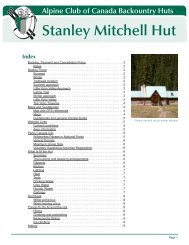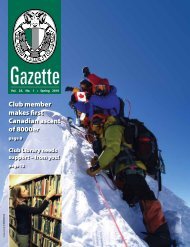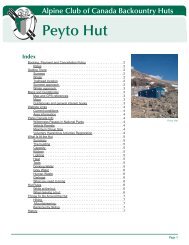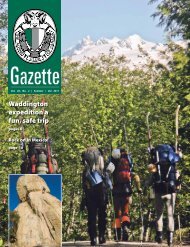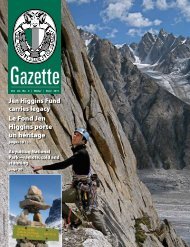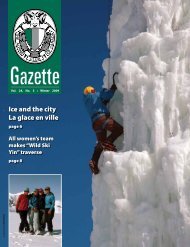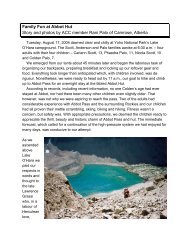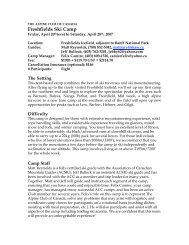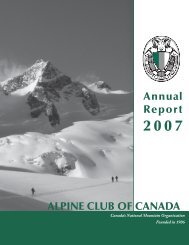Winter 2010 - The Alpine Club of Canada
Winter 2010 - The Alpine Club of Canada
Winter 2010 - The Alpine Club of Canada
- No tags were found...
Create successful ePaper yourself
Turn your PDF publications into a flip-book with our unique Google optimized e-Paper software.
And Carstensz Pyramid makes six...<br />
by Gordon Hopper<br />
After Elizabeth Tertil and my<br />
thwarted attempt at 8,400 metres<br />
on Everest in 2009 because <strong>of</strong> a<br />
rescue we had to instigate and organize,<br />
and also due to the early arrival <strong>of</strong> the<br />
Monsoon within hours <strong>of</strong> the rescue, we<br />
decided to tackle the only other summit<br />
left on our quest for the Seven Summits,<br />
namely Carstensz Pyramid in West<br />
Papua or Irian Jaya, Indonesia.<br />
<strong>The</strong>re is controversy as to which<br />
mountain is the seventh summit. Some<br />
say that the Australian continent is all<br />
that should be considered, while others<br />
believe the Island <strong>of</strong> Papua is on the<br />
same continental shelf as Australia.<br />
Mount Koscuiszko, at 2,228 metres and<br />
apparently accessible to the summit<br />
by Landrover before it became a park,<br />
is hardly worthy <strong>of</strong> the status. I think<br />
the majority <strong>of</strong> climbers would agree on<br />
Carstensz being the true seventh summit,<br />
as well as the most technically demanding<br />
<strong>of</strong> all the Seven Summits.<br />
From Calgary it took eight flights to<br />
reach base camp on this remote, most<br />
southerly island <strong>of</strong> Indonesia. You must<br />
have the necessary government permits<br />
before even seeing the mountain otherwise<br />
you will be turned away. <strong>The</strong>refore,<br />
it is essential to go with a reputable<br />
outfit. After waiting a few days in the<br />
town <strong>of</strong> Nabire for suitable weather, we<br />
took the 75-minute flight by helicopter<br />
Base camp.<br />
photo by Gordon Hopper.<br />
from sea level to the base camp at 4,200<br />
metres. You can also walk through the<br />
jungle for six days but this is fraught with<br />
major problems with the local tribespeople<br />
demanding extortionate increases<br />
in payments for portering and crossing <strong>of</strong><br />
their areas <strong>of</strong> jungle halfway through the<br />
trip. One must remember that they were<br />
cannibals in the not too distant past and<br />
they insist on portering your kit across<br />
their lands. Other problems include drug<br />
resistant malaria as well as the gambit <strong>of</strong><br />
other nasty tropical diseases, plus daily<br />
temperatures <strong>of</strong> 30 to 40 degrees C with<br />
100 per cent humidity.<br />
After a thrilling helicopter flight that<br />
took us over the jungle and a giant open<br />
pit copper and gold mine— flown by the<br />
only helicopter pilot willing to fly the<br />
route—we set up our camp, ate and rested<br />
to prepare for our 3 a.m. wakeup call, as<br />
an early start is best to avoid the usual<br />
daily afternoon tropical deluge.<br />
After breakfast, our group <strong>of</strong> six and<br />
local guide left in the dark for the base<br />
<strong>of</strong> the 600-metre rock wall <strong>of</strong> up to 80<br />
degrees which led on to the summit ridge<br />
<strong>of</strong> the mountain. <strong>The</strong> ascent entailed rock<br />
climbing with the assistance <strong>of</strong> an<br />
ascender on fixed ropes. Soon after<br />
attaining the ridge, we came upon our<br />
first major obstacle, a 30-metre Tyrolean<br />
traverse on ropes over a very deep gash on<br />
the ridge with a 600-metre drop <strong>of</strong>f on<br />
Climbers gear up on Carstensz.<br />
Hopper.<br />
photo by Gordon<br />
each side. This caused lots <strong>of</strong> entertainment<br />
as well as major adrenalin release.<br />
It was rather strenuous on the forearms<br />
pulling uphill against the friction <strong>of</strong> a<br />
loaded carabiner, and I have to admit<br />
to having my eyes closed for half <strong>of</strong> the<br />
traverse. We then proceeded along the<br />
ridge and came upon two unanticipated<br />
surprises, which consisted <strong>of</strong> two very<br />
exposed gaps. However, after reassurance<br />
from our guide we, one by one, took<br />
the plunge and crossed these obstacles.<br />
Fortunately the rock had a very rough<br />
surface and provided excellent grip. It<br />
was then an uneventful final 50 metres to<br />
the summit.<br />
We had lots to celebrate, as for one <strong>of</strong><br />
our members it was the final <strong>of</strong> the Seven<br />
Summits, for four it was number six and<br />
for one it was the fifth. <strong>The</strong>re was lots <strong>of</strong><br />
sun and thin cloud around the summit<br />
with almost no wind, which is most<br />
unusual for this mountain.<br />
After about an hour <strong>of</strong> celebration and<br />
picture taking, we started our descent.<br />
We again negotiated the three adrenalin<br />
releasing crossings and reached the<br />
60-metre, 80 degree rappel down the first<br />
rock wall. Soon after commencing our<br />
descent on this wall, the afternoon rains<br />
started, along with thunder. Fortunately,<br />
the thunder did not come too close as we<br />
had lots <strong>of</strong> metal hardware attached to<br />
our harnesses. Following an uneventful<br />
but rain drenching descent, we reached<br />
base camp where we changed into dry<br />
clothes and disappeared into our sleeping<br />
bags for the evening and night,<br />
24 <strong>Alpine</strong> <strong>Club</strong> <strong>of</strong> <strong>Canada</strong> Gazette <strong>Winter</strong> <strong>2010</strong>



